Lupine bloom

In Russia, the vast majority of varieties and species bloom in the second half of summer. In order to extend the flowering period, gardeners recommend timely cutting off dry inflorescences before the formation of seeds on the bush. Such a simple method will allow you to extend the enjoyment of bright inflorescences until autumn.
Depending on the variety of lupine, the inflorescences differ in length, shape and palette. On some shrubs, the buds grow up to a meter in length, while on others, the inflorescences are short and long. As for the shade, the flowers are yellow, white, red, pink, crimson, however, the flowers of the blue palette are considered dominant. Today, varieties with bicolor inflorescences have also been bred. The structure of the lupine flower is quite peculiar and fully corresponds to the structure of the flowers of the legume family, which is why lupine also belongs to this species.
Diseases and pests
Among the pests that threaten perennial lupine, one can note those affecting young seedlings and seeds.
- May beetle larvae. Thick, coiled, ring-shaped whitish caterpillars feed on roots, spoil young seedlings, destroying them in a short time.
- Weevils. These pest beetles leave very voracious larvae that mine leaves, buds, petioles, and shoots. Often, weevils appear on lupins already affected by fungal diseases.
- Wireworm. The pest affects the root system, which in lupine is a massive, well-developed stem. Its attacks can quickly disrupt the normal nutrition of the plant.
The main danger of insect pests from this group is during the growing season of the plant, in spring. In this case, there is only one method of struggle - soil treatment, which makes it possible to eliminate development conditions favorable for parasites. For perennial lupine in adulthood, such insects are dangerous.
- Aphid. A pest whose entire colonies can become a serious problem for the garden. In lupins, it affects the skin, sucks out juices, and leads to the appearance of chlorosis. Fungal cultures are actively proliferating on the affected tissues.
- Firefighter. It affects the leaves, when caterpillars appear, they curl, pests can eat pods with seeds and even flower petals.
- Thrips. Small insects feeding on plant juices can gradually lead to the death of perennial lupine. Thrips are quite difficult to get rid of.
Among the diseases that affect plant organs, the most dangerous are rust, root rot, fusarium. These are infectious diseases that easily affect large populations of varietal lupins. In addition, they are not protected from viruses - a mosaic that causes mutations, and other sources of danger. The main way to deal with infections is soil reclamation followed by the introduction of lime, the treatment of plants with fungicides, if the shoots are severely damaged, they are pruned at the root.

Types and varieties of annual lupine
Annual lupine, as we have already mentioned, is successfully used both in fodder and green manure culture. There are now about 20 varieties of lupine in the State Register, so there is definitely something to choose from.
Scientists have found that lupine, during its growth, for its own defense, produces a significant amount of alkaloids, that is, nitrogen-containing substances that protect their host (plants), and these, in turn, quite effectively inhibit and can even suppress the development of various pathogenic bacteria, kill the nematode , get rid of root rot.
White lupine (Lupinus albus)
It is very drought tolerant and does not require pollinators, but adores warmth.This lupine cannot be called a baby, it can easily stretch two meters, and the length of its inflorescences reaches three tens of centimeters. As soon as the flowering is over, its fruit (bean) immediately begins to form, each of which contains from three to six snow-white, cuboid seeds.
As a green manure, the most commonly used varieties are Desnyanskiy 2 (this is a more improved variety from Desnyanskiy, which was obtained back in 2003), as well as Gamma and Degas. The remaining eight varieties, which are included in the State Register, are also good, but they usually go to feed livestock, because they accumulate very little or do not accumulate alkaloids at all. White lupine has, however, a drawback: it loves constant loosening of the soil, poorly tolerating the soil crust and will not refuse fertilizing with potassium sulfate (10-15 g per square meter 2-3 times with incorporation into the soil).
Lupine narrow-leaved (Lupinus angustifolius)
It is also a plant that does not require pollination, but a lower one and a half meters is the limit for it. Despite the fact that they call it blue, the inflorescences of this lupine may well be pink, pale white, and of course, purple and actually blue. The seeds are often round, but if they sell you barrel-shaped seeds, don't be alarmed, they can be that too, which is perfectly normal. The main thing is to take a closer look at the seeds, they should have something resembling a marble pattern. Lupine narrow-leaved as a green manure is often used, it is surprisingly unpretentious and winter-hardy, grows quickly and does not require additional feeding.
Most often, its varieties are used as siderates: Siderat 38, Benyakonsky 334, Pink 399, Benyakonsky 484, Nemchinovsky blue, Vityaz, Crystal, Snezhet, Raduzhny, Belozerny 110, Nadezhda, Smena, Narrow-leaved 109 and others. Often, these varieties are used as green manure and are used as feed for farm animals because of their high nutritional value. The only exception is the Siderat 38 variety. The fact is that during its cultivation an interesting fact was discovered: in the roots it contains derivatives of ethyl alcohol and, for obvious reasons, such plants do not go to livestock feed.
However, when grown as a green manure crop, this variety simply has no equal, it grows actively, and noticeably quickly increases both the aboveground mass and the root system. If we compare yellow lupine and this variety, then we can highlight clear advantages over resistance to cold weather, including in the late spring periods. It can grow on highly acidified soil types, gradually neutralizing them year after year.
It is also interesting and very valuable that this type of lupine takes more nutrients from the lower layers of the soil, therefore, in fact, there is no need to wait for the complete decomposition of the vegetative mass after plowing, there is enough nutrition for the plants in the upper layers of the soil.
Yellow lupine (Lupinus luteus)
This plant is a typical "crossroads", not tall, usually no more than a meter in height. Its inflorescence resembles a spikelet, yellow or light orange in color. Fully ripe beans sometimes contain up to five beige seeds, less often with a small speck, which many mistake for a disease.
If we compare this lupine and narrow-leaved lupine, then we can say that yellow is significantly more thermophilic, so even in order for its shoots to appear, it needs at least 12 degrees of heat, although it can endure return frosts, having withstood from four to six degrees of frost. This lupine also needs watering, at least once a season in the amount of a couple of buckets per square meter of soil, and lupine will grow better on sandstones and sandy loams, improving them. Most often, these varieties of such lupine are grown here - Gorodnensky, Siderat 892, Akademichesky 1, Kastrychnik, Motiv 369, Fakel, Prestige and Peresvet.
White lupine (Lupinus albus) Narrow-leaved lupine (Lupinus angustifolius). Ghislain118 Yellow lupine (Lupinus luteus). marce
Summer Lupine Care
As with the care of all flowers, in the plantings of the first year of lupine, it is necessary to loosen the soil more often, while removing the weeds. Next spring we feed the flowers with mineral fertilizers, you can use superphosphate and potassium chloride. If we notice that the root collar is bare above the ground in old bushes, we spud the plant to form new lateral roots. We change perennials after four years, since the flowering of these specimens is weakening.
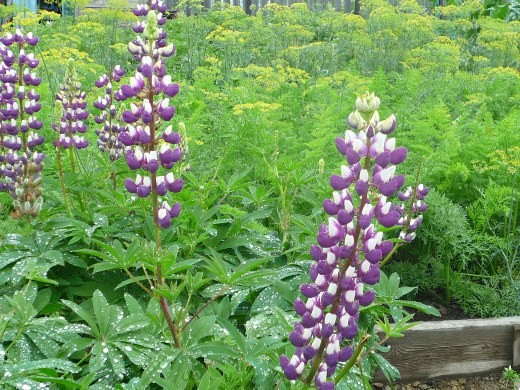
If you are more fond of annual varieties, then we sow them in the country at a permanent place in the month of April. Lupine is unpretentious, tolerates frost well, but does not greatly respect the sharp change in temperature. If you want the lupine to delight with its flowers as long as possible, it is necessary to cut off the dried inflorescences, and this must be done before the seeds are formed, then new inflorescences grow in the place of the cut ones, and the plant will bloom again in August. If strong winds blow in the places of planting and growing flowers, we tie up adult plants to stakes or make a fence out of wire, all this will prevent the flowers from breaking.
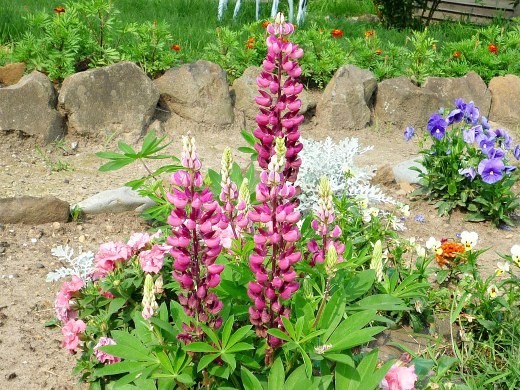
Subtleties in flower reproduction
If you welcome seed propagation, keep in mind that such plants rarely retain their original color, a color change occurs. To preserve the original color, vegetative propagation is required. It is better not to divide old plants, because they have a tap root system that goes deep into the ground. The easiest way is to divide the younger lupine bushes, forming side rosettes. In the summer they are separated and seated. Young lupins take root most easily.
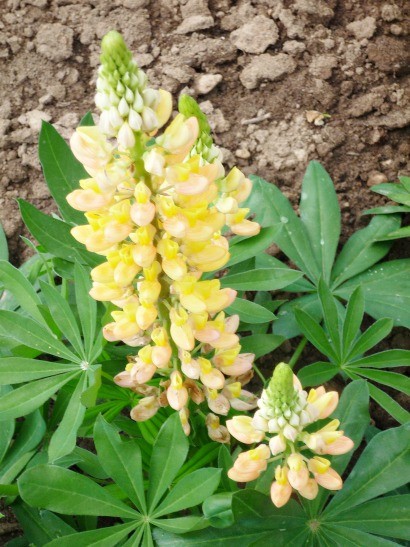
If you need personal seeds for planting
With the onset of hot days, the maturation of the stigma and anthers occurs faster and the plant self-pollinates in a closed flower. But, as a rule, pollination is carried out by insects. Since the plant is relatively young, breeding work continues in many countries. Breeders-summer residents strive to enhance the aroma of lupins, change color and lengthen the flowering period.
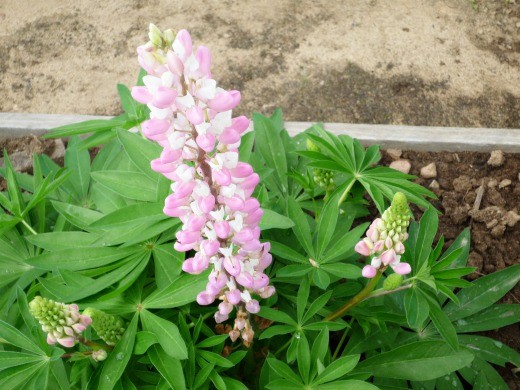
There are no pests, but the disease?
After talking about breeding and grooming, I said nothing about diseases affecting lupins. These are mainly fungal diseases - powdery mildew, rust, white rot that affects the root system, and brown spot that spreads to fruits and leaves. If there is time, then Topaz or Speed will be used. Since lupine is very hardy, the peculiarity is that the growing shoots are absolutely healthy, so the affected parts are usually simply removed. Well, now, probably, that's all, choose a color scheme, type of plant and go for it. With timely care, lupines will bloom beautifully and for a long time, transforming the landscape design of your summer cottage.
Diseases and pests
Lupine can be affected by diseases and pests. The most common are the following:
- Rust. It manifests itself as convex orange spots, is removed by fungicides or onion and garlic infusions.
- Ring spot produces red or brown spots. They are treated with copper-containing drugs, such as Bordeaux liquid or copper sulfate.
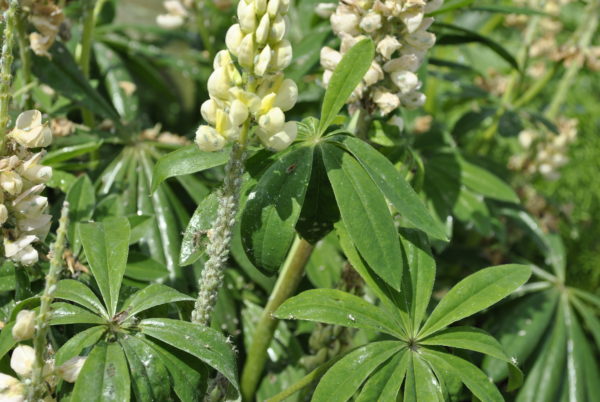
- The mosaic forms green patterns lighter than the entire leaf plate; it is necessary to disinfect the soil with appropriate substances.
- Various types of rot, both stem and root, lead to the death of lupine. If noticed right away, it can be spilled against fungus.
- Common pests include aphids feeding on tops of plants, weevils and sprout flies. The plant is well watered with a hose, knocking down insects, then treated with soapy water from laundry soap, insecticidal preparations.
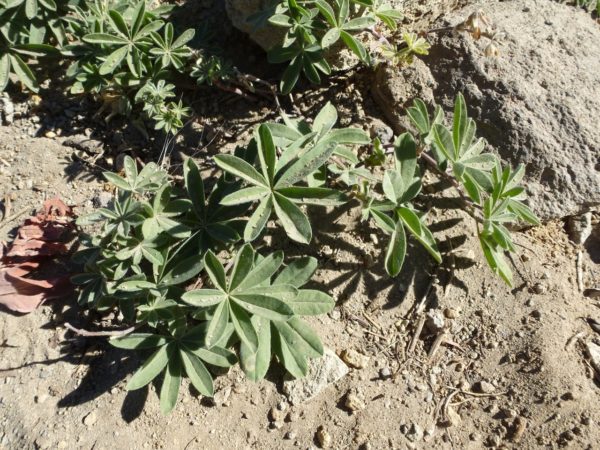
Fact! With the correct fertilization, especially potassium and phosphorus, you can increase the resistance of plants to diseases.
Lupins - growing
Bright lupine, planting and care in the open field, which are carried out competently, will delight you with flowering already in the first season.Colorful buds-cobs appear on it in June-August. Lupins - proper cultivation and care:
- adult plants need to be hilled to protect the root collar, which rises above the ground every year;
- after 4-5 years, bushes - centenarians are removed, new specimens sit down;
- tall specimens must be tied up so that the stems do not break from the wind;
- to prolong flowering, wilted rosettes can be cut off before the seeds appear;
- for the prevention of diseases, wood ash is introduced into the open ground;
- if it is necessary to collect the seeds, the fruit must be plucked as soon as it begins to dry so that the seed does not scatter to the sides spontaneously;
- perennial bushes are sprinkled with sawdust for the winter, otherwise the plant may not tolerate frost below -8 ° C.
Lupine - transplant
The plant acquires a pivotal, powerful and deep root system - extending up to 2 m into the ground. Therefore, it is better to move young specimens, since it is harder to transplant lupine at an older age - it can hurt for a long time after the procedure. This is because long taproots break off easily and do not recover well. If you still need to move the bush to another place, then it is better to do this in the fall after flowering. It is better to renew such perennials every 5-6 years by sowing seeds, because old plants are no longer blooming so luxuriantly.

Lupine in the garden - reproduction
Garden lupine, planting and care in the open field, which is carried out according to the rules of agricultural technology, is propagated by dividing the bush. In the spring, from the buds located near the root collar, small rosettes of 5-7 leaves appear. They can be used for cuttings. The sprouts are cut off together with a piece of the root collar. They can be planted in a shaded area in sandy soil. After 25 days, a root is formed on them and the flower can be planted in a permanent place.
Rosettes develop by mid-summer and can also be used to expand the plantation of bright flowers. 3-4 year old plants are ideal for dividing. Vegetative propagation of lupine by rhizome allows you to completely preserve the color of the flowers. When planting cuttings in the summer (after flowering), lateral shoots formed in the leaf axils can also be taken for germination.
Lupine disease
Sometimes lupine, which was planted and cared for in the open field in violation of agricultural technology, can be exposed to disease or attack by pests. At the stage of budding, the plant damages aphids, later - the larvae of the sprout fly or nodule weevils. Spraying the bush with Aktellik and Apollo insecticides will help you quickly get rid of them.
Of the diseases, rot (root and gray), mosaics, spots, rust, phomopsis are dangerous to the flower. As a result, brownish spots appear on foliage, fruits, damage in the root part. In this case, it is advisable to treat the bushes with fungicides, cut off the diseased bush completely or remove the affected parts of the plant. New shoots emerge quickly from the root remaining in the open field and are healthy. Sometimes you need autumn digging and liming of the substrate.
Knowing how to grow lupine, observing the rules of crop rotation and care, you can ensure that the plant practically does not hurt
It is important to know: you can re-place the plant in one area after five years, otherwise the soil under it begins to overgrow with weeds more intensively, accumulates phytotoxic microorganisms, leading to various diseases
Lupine care
Lupine is an extremely undemanding plant, so in order for it to please you with abundant flowering, it is enough to follow a few simple rules.
- Make sure that there are no weeds near the young plant.
- Avoid overflow and soil stagnation. Watering is minimal, only during dry periods.
- In plants that have reached the age of 3-4 years, the basal neck is very often exposed.To prevent this from happening, periodically loosen and huddle them.
- If you do not plan to engage in seed reproduction of lupine, it is imperative to remove the ripe seed pods, otherwise you run the risk of a self-seeding problem, since an extremely unpretentious plant can "dig in" in the most inappropriate place for this and it will be very difficult to get rid of it.
- Lupine usually blooms in late May or early June, but you can stimulate a second wave of flowering by removing already wilted heads. It is likely that by August the plant will delight you with its flowers again. Most likely, they will not be as lush as in early summer, but they can add a little color to the bright pre-fall palette of the flower garden.
- If you are going to plant tall varieties of lupine on your site, then you should think in advance about how to tie up grown specimens.
- By the age of 4-5, the middle part of the bush will begin to die off, and the flowering will noticeably deteriorate. This process is as natural as it is irreversible, therefore, after this time, the old plant will have to be uprooted.
Planting and leaving
Lupine will not burden you with the responsibilities of self-care.
Where is better to plant, what kind of soil is suitable
It is better to grow it in lighted, sunny places, small shading is also suitable. It is no coincidence that in nature lupine grows on heights and slopes - water does not stagnate there, which is deadly for the roots.
Any soil will do, preferably drained so that the water leaves. Weakly acidic loams, sandy, soddy, neutral soils will be good for lupine. If necessary, add peat (to alkaline soils) or lime (to acidic soil).
Over time, the fertility of this area will increase, and all this is thanks to the lupine.

We plant with seeds in open ground
Lupines can be planted outdoors with seeds or seedlings. This is done in early spring or after the first frost in the fall.
In April or May, we sow beans in the beds from a mixture of peat, sand and turf. They need to be deepened by 3 centimeters. Flowering will occur only next year.
In October-November, we deepen the seeds into the ground in the same way. The distance between them is 20 - 50 centimeters. Our lupine will bloom next spring.
To make lupine seeds germinate more easily, we will specially prepare them. They are in a thick shell, and in order to germinate more easily, it must be damaged (without touching the inner layer).
This can be done by arranging the temperature "stress" for the beans (put in the freezer for a while, then dipped in hot water), or rub the surface with sandpaper (or a sharp knife, scalpel).
Is the top shell cracked? Let's start landing.
How to sow seedlings
- Time - March or April;
- I take containers or peat tablets, pots. I do this - I immediately sow in separate cups of peat, so as not to injure the roots of the lupine when planting;
- I buy the land in the store, where flower substrates are specially prepared. But you can prepare the mixture yourself;
- Seeding depth 0.5-1 cm;
- Spray the soil surface from a spray bottle and cover with glass or film;
- We put in a warm, bright place;
- The sprouts will appear in 10-15 days, and when they harden, we remove the film.
We plant our plants on the street, as soon as the frost leaves. Bet that lupine should have at least 4-6 leaves.
The landing pattern is as follows: 30, 40, 50 centimeters. Depends on the variety and on what density you yourself want.
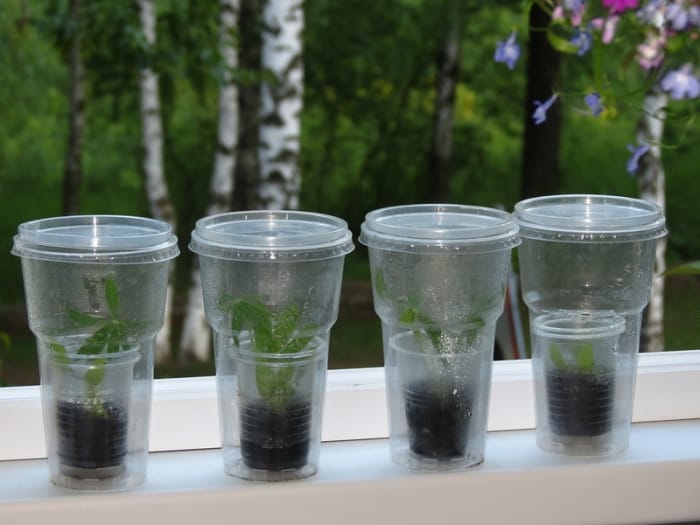
Propagation by cuttings
At the base of the plant (in the root part) there is a growing point - a kidney, cutting off which, you can effectively propagate lupine. The soil for these purposes should be loose and light, in partial shade. Quickly add a shoot with a bud and water it.
The buds appear in the spring, respectively, the procedure is performed early in the spring.
In the same way, I plant young shoots from the axillary spaces of the leaves. This method is applied after the end of flowering.
How to harvest lupine seeds correctly
In order for the plant to grow healthy and strong, you also need to learn how to collect lupine seeds on time. So, this is done only after the fruit ripens, which lets you know about the readiness of the seeds inside it by cracking. However, when the fruit spontaneously opens, the seeds fall out of it and scatter chaotically, subsequently, you lose the opportunity to grow them according to the rules.

Lupine seeds
To prevent this from happening, the seeds must be removed from the fruit when it:
- slightly yellow;
- will begin to dry out.
The procedure for pulling out the seeds will have to be performed several times and from several bushes in order to increase the number of potentially subsequently grown bushes.
Perennial lupins - planting and care
This is a really unpretentious plant that does not require any special growing technology. Most importantly, you need to know what kind of soil lupine prefers, as well as the period of its planting.
This flower thrives equally well in shady or sunny places. If you want to achieve the highest decorative values, then settle it in a shaded area of the site.
He loves slightly alkaline non-acidic soil, with increased acidity it will grow very frail, and on alkaline soils it can get chlorosis. This situation can be changed by first adding dolomite flour (or lime acid) to the soil.
Perennial lupine is sown after the snow melts, around April. The plot of land on which flowers will grow should be prepared in the fall. It is recommended to treat seeds before sowing with foundation (50% solution). With this approach, you can see the first flowers after 12-13 months (they usually bloom by May).
Seeds (beans), photo:
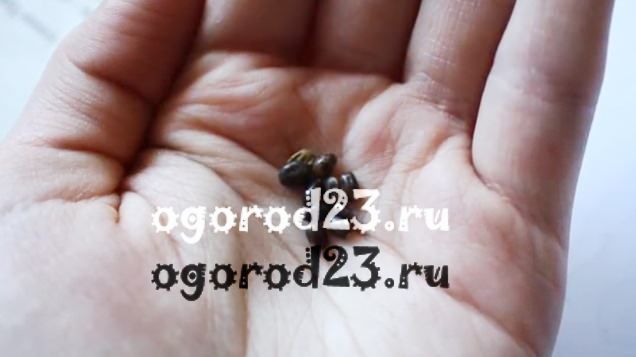
To get lupine seeds, a few pods should be left on the plant, which will dry out, ripen and give the necessary seed. During flowering, wilted inflorescences are usually removed - this is necessary so that the growth of new flowers is not inhibited, and self-seeding does not occur.
Leave a few inflorescences until fully ripe (preferably in August), if you do not have lupines yet, then the seeds can always be bought at flower shops. The pod must be completely dry (moisture is unacceptable), the extracted beans must also be thoroughly dried. It is best to store the seed in a glass container or in fabric, paper bags.
Pods, photo:
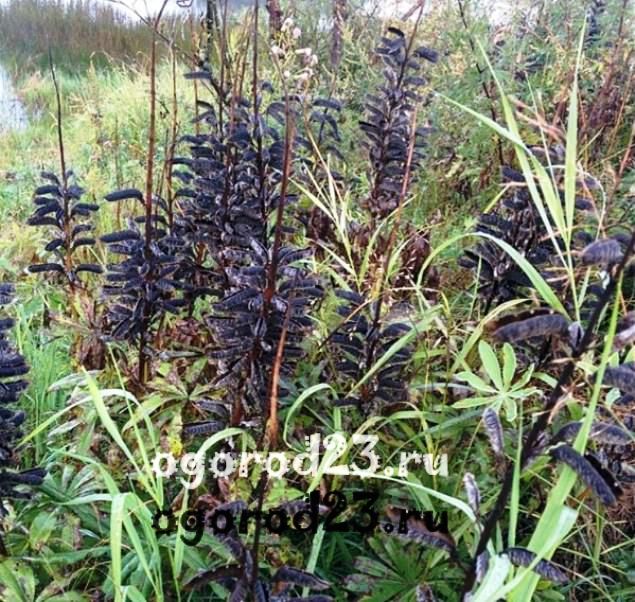
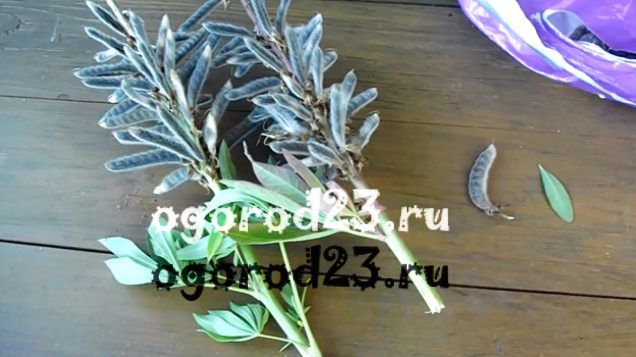
Lupine as a cultivated plant
A feature of lupins are peduncles, which are long apical brushes dotted with many flowers. When ripe, the flowers form fruits in the form of swollen beans. After reaching maturity, the beans burst and scatter seeds. These are very small and light grains. Because of this, the lupine flower has another popular name - wolf beans. In the national economy, forage species are grown, the value of which lies in the presence of nutritious beans and a large amount of green mass.
This same green mass is the reason that many gardeners grow lupine as green manure. The humus of the leaves and stems of the plant becomes an excellent fertilizer for vegetable and fruit crops.
Lupine flower beds will be an attractive decoration for any garden or yard.
A deep crimson lupine is planted near a garden hedge.
The most common option in summer cottages is the wild perennial lupine, whose flowers are blue in color. But at the moment there are a huge number of cultivated species with different colors, for example, lupine is white, yellow, cream, purple, lilac or bright red. The combination of plants with flowers of various colors can create an aesthetically pleasing composition that decorates the site. For example, lupine yellow is ideally combined with fellow lilac shades.
The annual lupine and its many cousins will bloom from late spring to early fall. Any of them will decorate your garden.
Lupine inflorescences of a delicate beige color can participate in complex landscape compositions or act as an independent decoration.
Unpretentious lupine looks creative on a personal plot. Tall ears of purple hues are a delicate, refined decoration.
The use of lupine in traditional medicine
In folk medicine, oil made from plant seeds and various decoctions from green mass, roots and flowers are often used.

Treatments for getting rid of scars
Soak the grains for 5-6 hours in warm water. 1 tbsp. Boil a spoonful of Lupine grains in 200 g of water. Drink the broth together with the grains 2 times a day for 1 glass. Grind and boil green grains. Apply as a compress. Grind ripe grains into flour on a mixer. Mix with sunflower oil or boiled water. Apply as a compress.
Lupine decoction for dandruff
Mix 30 g moss, 50 g lupine seed flour, 30 g willow bark and add 1 liter of water. Boil for 10 minutes, drain. Wash your hair with broth for two weeks.
Remedy for the treatment of Staphylococcus aureus
Take 300 g of Yarrow, 250 g each of Lupine and Burdock leaves, 150 g each of Oregano, Nettle, Melilot and Plantain. 100 g of Rose hips, 50 g of Calendula and Chamomile flowers, Dandelion and Horsetail roots. Brew a thick broth, strain and take 1 spoon 3 times a day.
Ointment for abscesses and ulcers
Mix in equal proportions the flour from Lupine seeds and barley. Steam with boiled water until a viscous mass is obtained. This remedy is applied to ulcers from prickly heat, malignant tumors that burst ulcers on the head.
Lupine tincture for gangrene
You need to take 10 g of Lupine seed powder, 1 tbsp. a spoonful of honey and 2 tbsp. tablespoons of vinegar. Stir the mixture into a thick ointment (if necessary, add a little boiled water). The mixture is applied to rotting wounds and taken orally in 1 tbsp. spoon 3 times a day.
Lupine oil tincture for liver and spleen stagnation
Oil is squeezed out of the seed of the plant. For 20 g of butter, 1 tbsp. a spoonful of honey and 50 g of grape wine. This tincture should be taken 2-3 times a day on an empty stomach.
Lupine decoction to improve liver function and appetite
Cooking the broth. 10 g of Lupine seed flour, 100 g of vinegar, 2-3 tbsp. spoons of honey, 10 g each Ruta and Pepper. This tincture enhances the functioning of the liver and spleen, increases appetite and improves the functioning of the digestive tract.
Ointment for worms and with heavy periods
To prepare the ointment, you will need to mix 10 g of Lupin flour and 1 tbsp. a spoonful of honey. Such a remedy can be smeared on the navel or taken orally 1 teaspoon 3 times a day. It will help stop bleeding, relieve pain and expel unwanted parasites from the intestines.
Lupine decoction for worms
To prepare this broth, you need to brew 200 g of greens and plant flowers, add 30 g of honey, 10-15 g of Ruta, Pepper, 100 g of vinegar. Such a decoction is able to drive away menstruation and even cause a woman to have a miscarriage.
Ointment that helps with sciatic nerve inflammation
It is necessary to take 20-30 g of flour from the seed of the plant, add 2-3 tablespoons of honey, 20 g of flour from the Black Wolf's bast and steam in 100 g of boiled water. Stir until smooth and apply in the form of lotions.



